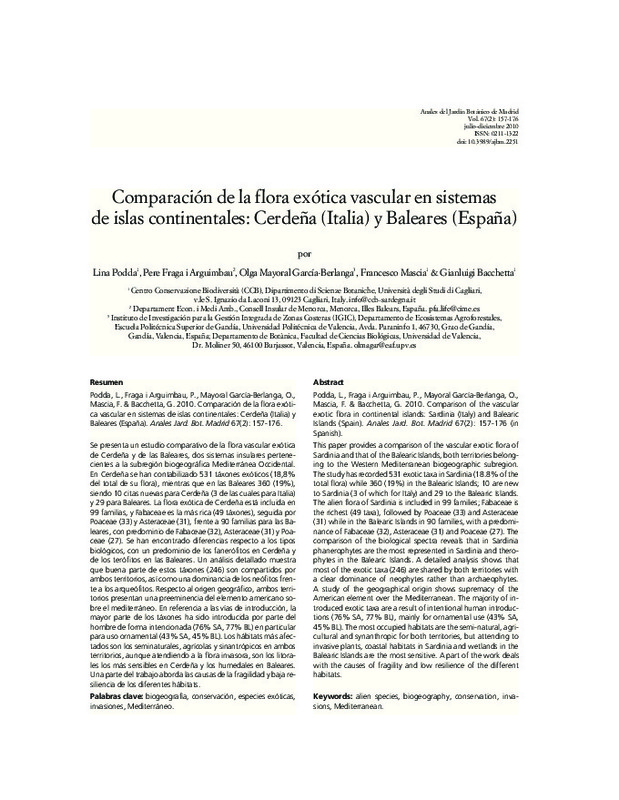Mack, R. N., Simberloff, D., Mark Lonsdale, W., Evans, H., Clout, M., & Bazzaz, F. A. (2000). BIOTIC INVASIONS: CAUSES, EPIDEMIOLOGY, GLOBAL CONSEQUENCES, AND CONTROL. Ecological Applications, 10(3), 689-710. doi:10.1890/1051-0761(2000)010[0689:bicegc]2.0.co;2
Madon*, O., & Médail, F. (1997). Plant Ecology, 129(2), 189-199. doi:10.1023/a:1009759730000
Mansion, G., Rosenbaum, G., Schoenenberger, N., Bacchetta, G., Rosselló, J. A., & Conti, E. (2008). Phylogenetic Analysis Informed by Geological History Supports Multiple, Sequential Invasions of the Mediterranean Basin by the Angiosperm Family Araceae. Systematic Biology, 57(2), 269-285. doi:10.1080/10635150802044029
[+]
Mack, R. N., Simberloff, D., Mark Lonsdale, W., Evans, H., Clout, M., & Bazzaz, F. A. (2000). BIOTIC INVASIONS: CAUSES, EPIDEMIOLOGY, GLOBAL CONSEQUENCES, AND CONTROL. Ecological Applications, 10(3), 689-710. doi:10.1890/1051-0761(2000)010[0689:bicegc]2.0.co;2
Madon*, O., & Médail, F. (1997). Plant Ecology, 129(2), 189-199. doi:10.1023/a:1009759730000
Mansion, G., Rosenbaum, G., Schoenenberger, N., Bacchetta, G., Rosselló, J. A., & Conti, E. (2008). Phylogenetic Analysis Informed by Geological History Supports Multiple, Sequential Invasions of the Mediterranean Basin by the Angiosperm Family Araceae. Systematic Biology, 57(2), 269-285. doi:10.1080/10635150802044029
MILBAU, A., & STOUT, J. C. (2008). Factors Associated with Alien Plants Transitioning from Casual, to Naturalized, to Invasive. Conservation Biology, 22(2), 308-317. doi:10.1111/j.1523-1739.2007.00877.x
O’Dowd, D. J., Green, P. T., & Lake, P. S. (2003). Invasional «meltdown» on an oceanic island. Ecology Letters, 6(9), 812-817. doi:10.1046/j.1461-0248.2003.00512.x
Olesen, J. M., Eskildsen, L. I., & Venkatasamy, S. (2002). Invasion of pollination networks on oceanic islands: importance of invader complexes and endemic super generalists. Diversity <html_ent glyph=«@amp;» ascii=«&»/> Distributions, 8(3), 181-192. doi:10.1046/j.1472-4642.2002.00148.x
Pauchard, A., Cavieres, L. A., & Bustamante, R. O. (2004). Comparing alien plant invasions among regions with similar climates: where to from here? Diversity and Distributions, 10(5-6), 371-375. doi:10.1111/j.1366-9516.2004.00116.x
Pyšek, P., Richardson, D. M., Rejmánek, M., Webster, G. L., Williamson, M., & Kirschner, J. (2004). Alien plants in checklists and floras: towards better communication between taxonomists and ecologists. TAXON, 53(1), 131-143. doi:10.2307/4135498
Randall, J. M., Morse, L. E., Benton, N., Hiebert, R., Lu, S., & Killeffer, T. (2008). The Invasive Species Assessment Protocol: A Tool for Creating Regional and National Lists of Invasive Nonnative Plants that Negatively Impact Biodiversity. Invasive Plant Science and Management, 1(1), 36-49. doi:10.1614/ipsm-07-020.1
REASER, J. K., MEYERSON, L. A., CRONK, Q., DE POORTER, M., ELDREGE, L. G., GREEN, E., … VAIUTU, L. (2007). Ecological and socioeconomic impacts of invasive alien species in island ecosystems. Environmental Conservation, 34(2), 98-111. doi:10.1017/s0376892907003815
REICHARD, S. H., & WHITE, P. (2001). Horticulture as a Pathway of Invasive Plant Introductions in the United States. BioScience, 51(2), 103. doi:10.1641/0006-3568(2001)051[0103:haapoi]2.0.co;2
Richardson, D. M., & Pyšek, P. (2006). Plant invasions: merging the concepts of species invasiveness and community invasibility. Progress in Physical Geography: Earth and Environment, 30(3), 409-431. doi:10.1191/0309133306pp490pr
Richardson, D. M., Pysek, P., Rejmanek, M., Barbour, M. G., Panetta, F. D., & West, C. J. (2000). Naturalization and invasion of alien plants: concepts and definitions. Diversity <html_ent glyph=«@amp;» ascii=«&»/> Distributions, 6(2), 93-107. doi:10.1046/j.1472-4642.2000.00083.x
Rosenbaum, G., Lister, G. S., & Duboz, C. (2002). Reconstruction of the tectonic evolution of the western Mediterranean since the Oligocene. Journal of the Virtual Explorer, 08. doi:10.3809/jvirtex.2002.00053
Sanz-Elorza, M., Mateo, R. G., & Bernardo, F. G. (2008). The historical role of agriculture and gardening in the introduction of alien plants in the western Mediterranean. Plant Ecology, 202(2), 247-256. doi:10.1007/s11258-008-9474-2
Schippers, P., van Groenendael, J. M., Vleeshouwers, L. M., & Hunt, R. (2001). Herbaceous plant strategies in disturbed habitats. Oikos, 95(2), 198-210. doi:10.1034/j.1600-0706.2001.950202.x
Schnitzler, A., Hale, B. W., & Alsum, E. M. (2007). Examining native and exotic species diversity in European riparian forests. Biological Conservation, 138(1-2), 146-156. doi:10.1016/j.biocon.2007.04.010
Speranza, F., Villa, I. M., Sagnotti, L., Florindo, F., Cosentino, D., Cipollari, P., & Mattei, M. (2002). Age of the Corsica–Sardinia rotation and Liguro–Provençal Basin spreading: new paleomagnetic and Ar/Ar evidence. Tectonophysics, 347(4), 231-251. doi:10.1016/s0040-1951(02)00031-8
Suehs, C. M., Affre, L., & Médail, F. (2003). Invasion dynamics of two alien Carpobrotus (Aizoaceae) taxa on a Mediterranean island: I. Genetic diversity and introgression. Heredity, 92(1), 31-40. doi:10.1038/sj.hdy.6800374
Towns, D. R., & Ballantine, W. J. (1993). Conservation and restoration of New Zealand Island ecosystems. Trends in Ecology & Evolution, 8(12), 452-457. doi:10.1016/0169-5347(93)90009-e
Vila, M., Tessier, M., Suehs, C. M., Brundu, G., Carta, L., Galanidis, A., … Hulme, P. E. (2006). Local and regional assessments of the impacts of plant invaders on vegetation structure and soil properties of Mediterranean islands. Journal of Biogeography, 33(5), 853-861. doi:10.1111/j.1365-2699.2005.01430.x
VITOUSEK, P. M., WALKER, L. R., WHITEAKER, L. D., MUELLER-DOMBOIS, D., & MATSON, P. A. (1987). Biological Invasion by Myrica faya Alters Ecosystem Development in Hawaii. Science, 238(4828), 802-804. doi:10.1126/science.238.4828.802
Wittenberg, R., & Cock, M. J. W. (Eds.). (2001). Invasive alien species: a toolkit of best prevention and management practices. doi:10.1079/9780851995694.0000
[-]








